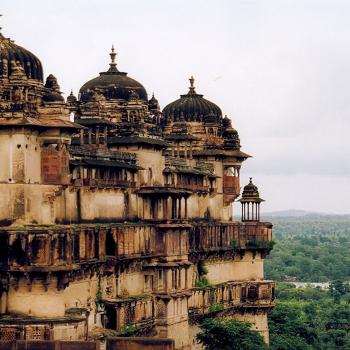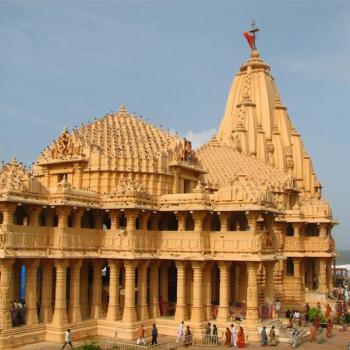People frequently misunderstand what the Khajuraho monuments are about, so I thought it apt to quote from Srinivasachari’s note on temples, now in the public domain.
No up-country traveller can afford to miss the Khajuraho temples which are among the most beautiful sanctuaries in the Gangetic Valley. Khajuraho or Khajurapura was the famous capital of the Chandella dynasty, which flourished in the tenth century and is celebrated in the songs of the poet Chand. It is in the heart of Bundelkhand in the United Provinces, and a sixty mile road connects it with Harpalpur station on the G. I. P. Railway.
Nothing remains of the past magnificence of the place but the thirty odd cathedrals which bespeak the wealth and glory of its rulers in the past. They are treasures of architectural perfection exemplifying the breadth of vision and vastness of sympathy evinced in the construction of cathedrals dedicated to Saivite, Vaishnavite and Jain deities. The Mahadeo temple is a holy mountain of masonry. “Every inch of the Kandarya Mahadeo temple is covered with carving. Over-elaborate the Purist might style it, yet there is nothing haphazard or superfluous about it; for each scrap of sculpture serves an appointed purpose, contributes its quota towards the majesty of the edifice as a whole. The Indian builder was a preacher as well as a creator. With the material at his disposal, he accomplished a twofold task; for not only did he raise a building consecrated to his religion, but by the manner in which he laid one stone upon another, he exemplified the tenets of that religion.
Mahadeo or Siva is the god of fertility, and the external carving illustrates the primitive notions associated with the philosophic concept.” This sanctuary is reminiscent of the sculpture galleries on the roof of Milan Cathedral as General Cunningham is reported to have counted no less than eight hundred and seventy-two statues in the temple, ranging from two and a half to three feet in height.
As the Kandarya Mahadeo temple is the bright particular star amongst the Saivite sanctuaries, so the Ramachandra temple heads the list of Vaishnavite places of worship. In plan, it is not unlike its Saivite prototype and bears an inscription dating from 954 A.D. Khajnraho affords golden opportunities for studying Vaishnavite shrines and it is a fascinating occupation to try and pick out their distinguishing characteristics. Vertical lines on the foreheads of his followers are emblematic of Vishnu and, in consequence, the sikharas or spires of his temples, symbols of Mount Meru, the mountain of plenty, of joyous life and generous nature follow these same vertical lines.
Among other attractions are the great halls or the mandapas forming the approach to the shrines, which lends a human touch to the archseology of Khajuraho; for in these vestibules, we are told, theatrical and musical performances nautch (dancing) and public meetings took place.
We have spoken of Saivite and Vaishnavite temples but Khajuraho still retains memorials of the Jain faith in abundance. The Jinanatha, the piece de resistance of the Jain temples, is the last of the “ Big Three ” monuments at Khajuraho. With its graceful pillars and profusion of sculpture, this Jain cathedral is one of the most illuminating architectural documents to be found throughout the length and breadth of India. According to a Chandella inscription, dating from 954 A.D., this building was one of the contemporaries of the Ramachandra temple.
Only one great relic of Buddhist days is now extant at Khajuraho, but that one great relic is amazing in its eloquence: for it consists of a colossal Buddha, dating from the seventh or eighth century A.D.: erected in India at a period when Buddhism was on the wane and Brahmanism was in the ascendant, this statue acted as a signpost at the cross-roads of religion.














